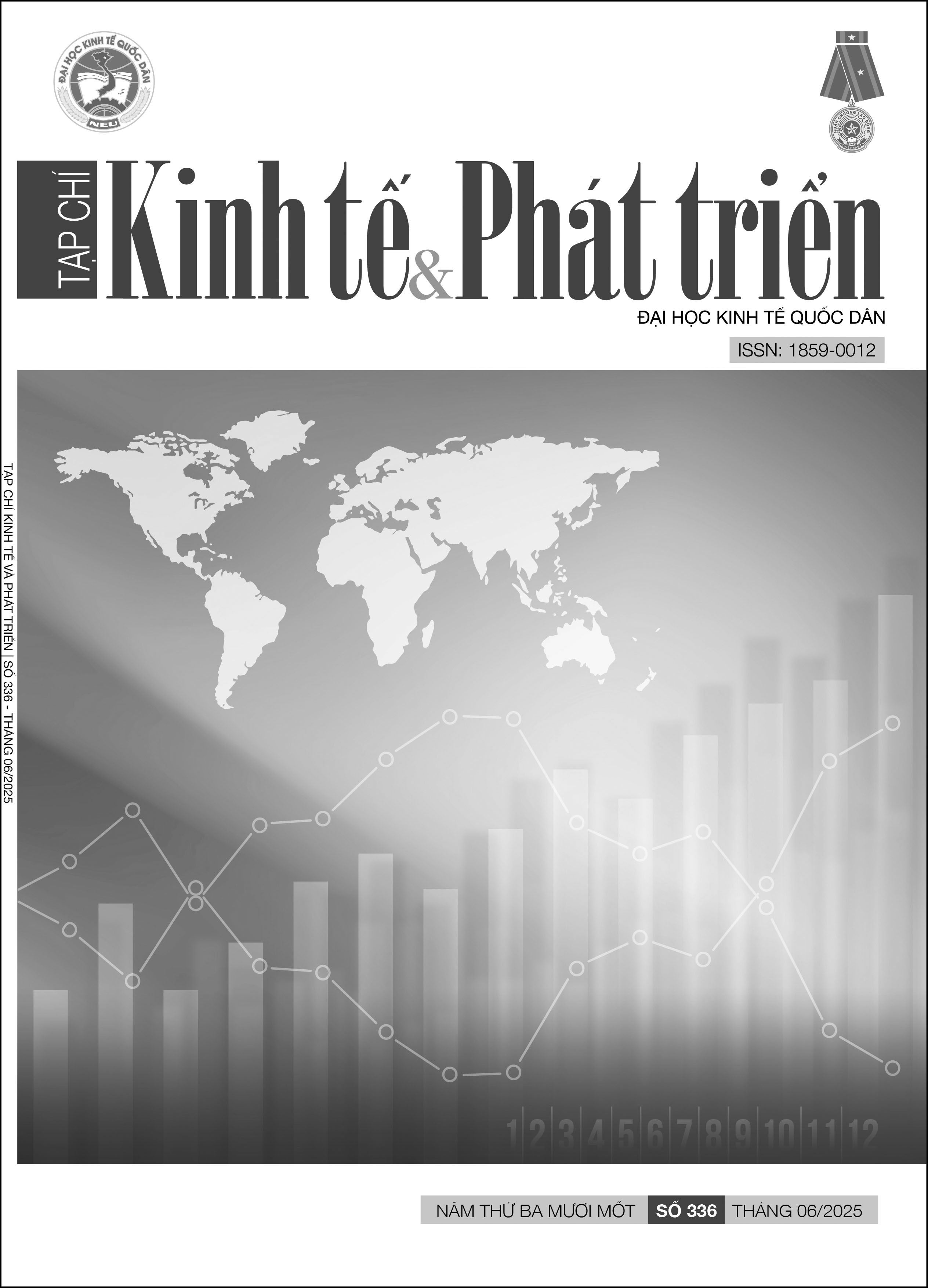Tác động của trải nghiệm đa chiều và nhận diện thương hiệu đến hành vi truyền bá điểm đến: Vai trò trung gian của trải nghiệm điểm đến của du khách
DOI:
https://doi.org/10.33301/JED.VI.2407Từ khóa:
Thương hiệu điểm đến, trải nghiệm của du khách, truyền bá thương hiệu điểm đến, nhận diện thương hiệu điểm đếnTóm tắt
Nghiên cứu này tập trung vào phân tích tác động của các chiều trải nghiệm cá nhân của du khách, nhận diện thương hiệu điểm đến tới trải nghiệm điểm đến với điểm đến và hành vi truyền bá thương hiệu điểm đến của du khách. Dữ liệu thu thập từ 317 du khách quốc tế được khảo sát tại ba địa điểm tập trung đông khách quốc tế ở Hà Nội và phân tích bằng mô hình PLS-SEM. Kết quả cho thấy cả bốn chiều trải nghiệm cá nhân đều tác động tích cực đến trải nghiệm thương hiệu điểm đến, trong đó trải nghiệm trí tuệ có ảnh hưởng mạnh nhất. Trải nghiệm điểm đến của du khách đóng vai trò trung gian trong mối quan hệ giữa các chiều trải nghiệm, nhận diện thương hiệu điểm đến và hành vi truyền bá thương hiệu điểm đến. Nghiên cứu cũng đề xuất các hàm ý quản trị cho chiến lược phát triển thương hiệu điểm đến nhằm tăng cường trải nghiệm đa chiều, nhận diện thương hiệu điểm đến và thúc đẩy hành vi truyền bá điểm đến của du khách.
Tài liệu tham khảo
Ashforth, B. E., & Mael, F. (1989), ‘Social identity theory and the organization’, Academy of Management Review, 14(1), 20–39.
Balakrishnan, M. S. (2008), ‘Dubai – a star in the east: A case study in strategic destination branding’, Journal of Place Management and Development, 1(1), 62–91.
Barnes, S. J., Mattsson, J., & Sørensen, F. (2014), ‘Destination brand experience and visitor behavior: Testing a scale in the tourism context’, Annals of Tourism Research, 48, 121–139.
Becerra, E. P., & Badrinarayanan, V. (2013), ‘The influence of brand trust and brand identification on brand evangelism’, Journal of Product & Brand Management, 22(5/6), 371–383.
Brakus, J. J., Schmitt, B. H., & Zarantonello, L. (2009), ‘Brand experience: What is it? How is it measured? Does it affect loyalty?’, Journal of Marketing, 73(3), 52–68.
Chi, N. T. P. (2024), ‘Unlocking the relationship between destination brand value and tourists' intentions to visit: A case study in Quang Binh province’, Journal of Tourism Management Research, 11(2), 178-192.
Chin, W. W. (1998), ‘The partial least squares approach to structural equation modeling’, Modern methods for business research, 295(2), 295-336.
Fornell, C., & Larcker, D. F. (1981), ‘Evaluating structural equation models with unobservable variables and measurement error’, Journal of Marketing Research, 18(1), 39–50.
Hair, J. F., Black, W. C., Babin, B. J., & Anderson, R. E. (2017), Multivariate data analysis (8th ed.), Cengage Learning.
Hair, J. F., Hult, G. T. M., Ringle, C. M., & Sarstedt, M. (2021), A primer on partial least squares structural equation modeling (PLS-SEM) (3rd ed.), SAGE Publications.
Hanna, S., & Rowley, J. (2011), ‘Towards a strategic place brand-management model’, Journal of Marketing Management, 27(5–6), 458–476.
Henseler, J., Ringle, C. M., & Sarstedt, M. (2015), ‘A new criterion for assessing discriminant validity in variance-based structural equation modeling’, Journal of the Academy of Marketing Science, 43, 115–135.
Hu, L. T., & Bentler, P. M. (1999), ‘Cutoff criteria for fit indexes in covariance structure analysis: Conventional criteria versus new alternatives’, Structural Equation Modeling: A Multidisciplinary Journal, 6(1), 1–55.
Hultman, M., Skarmeas, D., Oghazi, P., & Beheshti, H. M. (2016), ‘Achieving tourist loyalty through destination personality, satisfaction, and identification’, Journal of Business Research, 69(11), 5276–5280.
Kim, J.-H., Ritchie, J. R. B., & McCormick, B. (2010), ‘Development of a scale to measure memorable tourism experiences’, Journal of Travel Research, 51(1), 12–25.
Klaus, P. P., & Maklan, S. (2013), ‘Towards a better measure of customer experience’, International journal of market research, 55(2), 227-246.
Kuenzel, S., & Halliday, S. V. (2008), ‘Investigating antecedents and consequences of brand identification’, Journal of Product & Brand Management, 17(5), 293–304.
Kumar, V., & Kaushik, A. K. (2018), ‘Destination brand experience and visitor behavior: the mediating role of destination brand identification’, Journal of Travel & Tourism Marketing, 35(5), 649-663.
Rather, R. A. (2020), ‘Customer experience and engagement in tourism destinations: The experiential marketing perspective’, Journal of Travel & Tourism Marketing, 37(1), 15–32.
Scarpi, D. (2010), ‘Does size matter? An examination of small and large web-based brand communities’, Journal of Interactive Marketing, 24(1), 14–21.
Sharma, A. (2021), ‘Brand evangelism: A review and future research agenda’, Journal of Strategic Marketing, 29(7), 551–569.
Sohaib, M., Hussain, S., & Hameed, A. (2022), ‘Destination brand evangelism: Examining the role of destination brand experience, brand identification and destination satisfaction’, Journal of Hospitality and Tourism Management, 51, 220–229.
Tổng cục Du lịch Việt Nam (2022), Báo cáo tổng kết hoạt động du lịch Việt Nam năm 2022 và định hướng phát triển năm 2023, Bộ Văn hóa, Thể thao và Du lịch Việt Nam.
Tran, P. K. T., Nguyen, H. K. T., Nguyen, L. T., Nguyen, H. T., Truong, T. B., & Tran, V. T. (2023), ‘Destination social responsibility drives destination brand loyalty: a case study of domestic tourists in Danang city, Vietnam’, International Journal of Tourism Cities, 9(1), 302-322.
Walter, U., Cleff, T., & Chu, G. (2014), ‘Brand experience’s influence on customer satisfaction and loyalty: A study in premium automotive segment’, International Journal of Market Research, 56(1), 97–114.
Wilk, V., Sadeque, S., & Soutar, G. N. (2024), ‘Exploring online destination brand advocacy’, Tourism Recreation Research, 49(2), 283-301.





